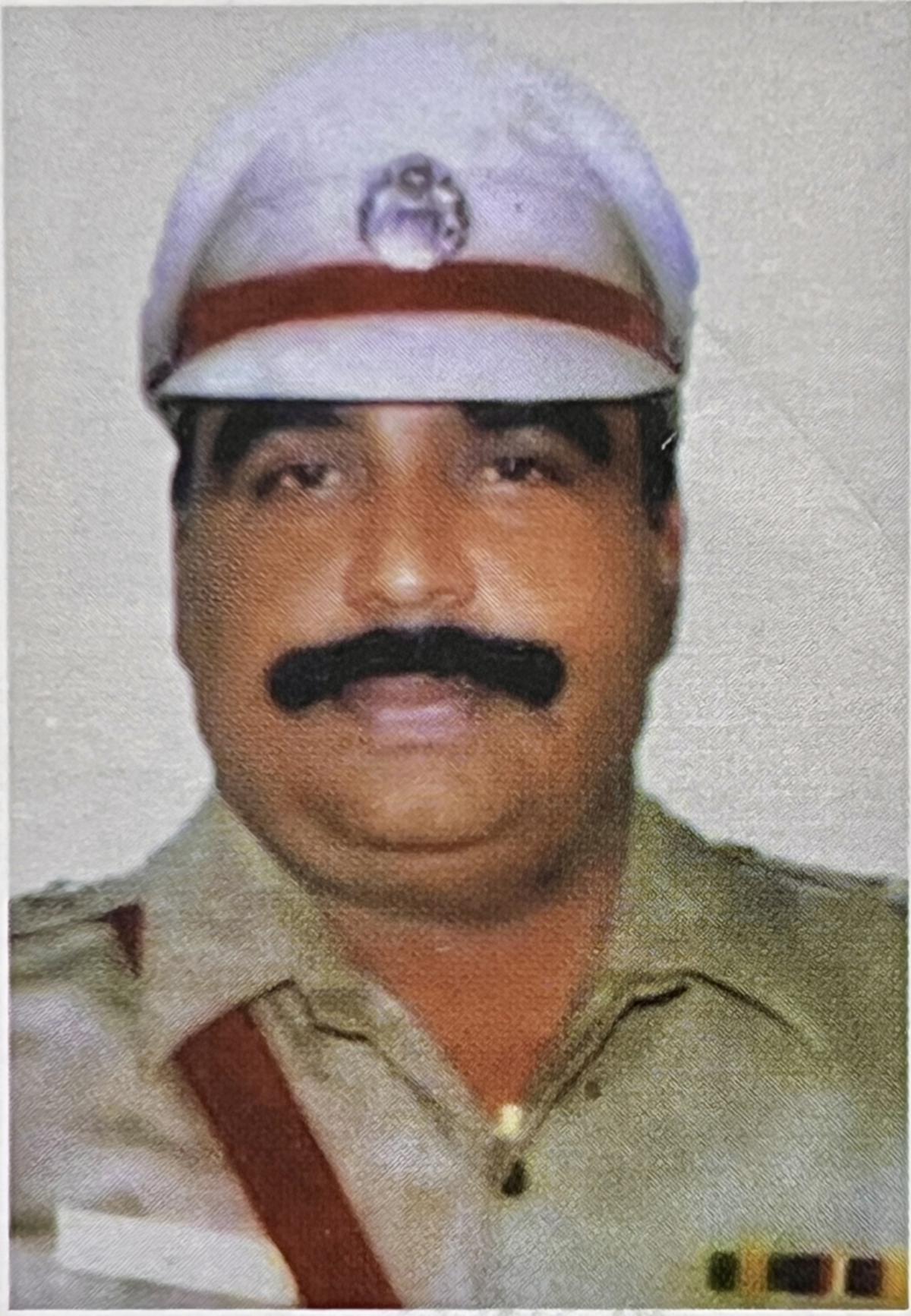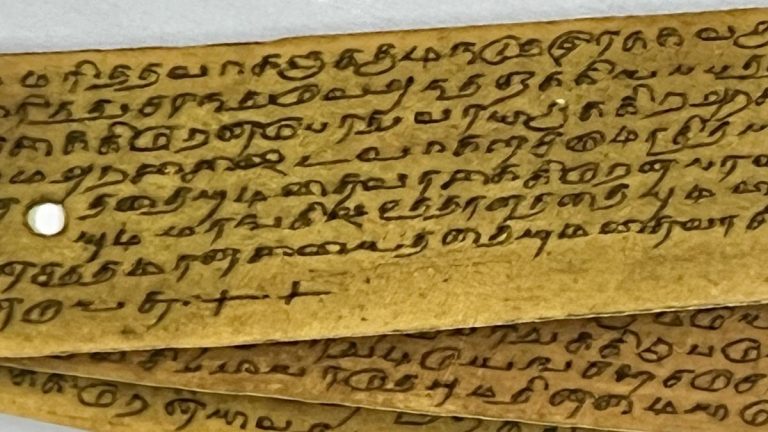
The forged palm leaf writings that Ganesh Iyer showed to the church authorities. On the right, G. Senrayaperumal, CB-CID inspector, who investigated the case. | Photo credit: Tamil Nadu Police
A calm demeanor, coupled with persuasive skills and in-depth knowledge of Christianity, was enough for Ganesh Iyer to introduce himself as “Evangelist Dr. John Ganesh”. It was in the early 1970s that he met Reverend Father for the first time. Michael from the Tamil Ilakkiya Kazhagam, posing as a religious researcher studying the roots of Christianity in India. In no time, John Ganesh was able to convince a gullible father. Michael, with his eloquence and numerous documents, demonstrating that he was fully committed to research into the origin and growth of Christianity in India and that some support from the Church would help accelerate his work. He was referred to Fr. Mariadas of Srivilliputtur, who did not know that the “visiting professor” was Ganesh Iyer, a native of Srirangam, involved in some cheating cases.

G. Senrayaperumal
In-depth knowledge of Christian theology
A Tamil Nadu police report, published in a newspaper, said: “Fr. Mariadas was no less impressed by John Ganesh’s deep knowledge of Christian theology. He showed her photographs of century-old writings on palm leaves and copperplate inscriptions that he said proved the origin and growth of Christianity in India.
At one point, John Ganesh said he was unable to continue his research and planned to travel to Kashmir “where the religion had deep roots.” Carried away by his claims, Fr. Mariadas collected funds and referred him to Archbishop Rev. R. Arulappa, head of the Catholic Church in Madras. It is interesting to note that Archbishop Arulappa was known for his literary activities. He had translated the New Testament into Tamil and had also rendered the life of Christ (Ulagin Uyir) into Tamil. In addition, he had learned Sanskrit and translated several Christian principles into that language. “As he was interested in research into Christianity, he was easily taken in by the apparent sincerity of John Ganesh’s intentions,” the police report states. The bishop agreed to fund the “research” based on his progress and this is how the accused found his “goose that laid the golden eggs”.
Thus began a false search in 1975-76. As proof of his work, John Ganesh submitted photocopies of palm leaf writings and copperplate inscriptions within a few months. When the archbishop wanted to see the originals, he claimed that they were kept securely in museums and facilities owned by archeology departments across the country. Stating that it would not be possible to get hold of the originals, he promised to have the documents attested by the respective directors of the museums. A few weeks later, he produced certificates with false seals and signatures.
Becoming Acharya Paul
Feeling that he had won the confidence of the archbishop, John Ganesh found the time opportune to begin his journey to Kashmir where he offered to get involved in research work. After receiving funds, the accused hatched a plan to make church authorities believe that he was indeed in Kashmir to work with their counterparts.
The archbishop received letters from some Christian and Hindu religious leaders in Kashmir informing him that they had met John Ganesh, who had now given himself the name Acharya Paul. The letters spoke in superlative terms of his noble researches. After two years of “searching”, Ganesh Iyer alias John Ganesh alias Acharya Paul was a rich man. He built two bungalows in Srirangam, bought expensive cars and had a good bank balance, the report said.
Another twist
Then came another twist in the story. The archbishop had so much confidence in John Ganesh that he took him to Vatican City in 1977. There they had an audience with Pope Paul VI. Ganesh Lyer took advantage of his visits abroad to give extensive lectures in many religious congregations and churches on comparative religions, the origin of Christianity in India and its revolutionary research.
The approval of the accompanying archbishop opened the floodgates of funds for him to continue his research. “However, the absence of the Archbishop of Madras provided an opportunity for well-informed members of the Church, led by John Thomas, editor of the daily Swadesamitran, to carry out an investigation into the activities of the suspect,” wrote G. Senrayaperumal, the then inspector of the Crime Branch-CID, who investigated the case.
A preliminary investigation revealed a cash shortfall of ₹14 lakh in Church funds spent in the name of research. The church committee passed a resolution ordering the archbishop to file a complaint with the police. Accordingly, a complaint was lodged with the CB-CID and a team, led by Mr. Senrayaperumal, raided Ganesh lyer’s house in Srirangam.
Investigators recovered the originals of all the photographs he had taken as evidence of his writings. The originals were just simple writings on strips of brown paper cut to look like medieval palm fronds, pasted onto sheets of white paper. Photographs he had taken at a studio in Tiruchi led to the seizure of the negatives. Police also seized seals, stamps and letterheads from several institutions he allegedly visited.
Ganesh Iyer was arrested on April 29, 1980 for cheating, forgery and impersonation. He was also detained under the Passport Act as he had obtained a travel document in the name of Acharya Paul for his visit to the Vatican City. He was sentenced to 10 months in prison for offenses under the Indian Penal Code and five months under the Passport Act. In his report “Religious Research by Acharya Ganesh Paul” (1975), Mr. Senrayaperumal states that the CB-CID had a delicate case to deal with. He had to investigate carefully without affecting community sensitivities. “This is a story of fraud, with comical touches, in which a pious church leader was taken for a ride by a conman. Unfortunately, the archbishop’s gullibility caused a loss of nearly Rs 14 lakh to the Madras-Mylapore Archdiocese. Quite a large sum in the mid-1970s, when gold was selling for around $400 per sovereign.”


